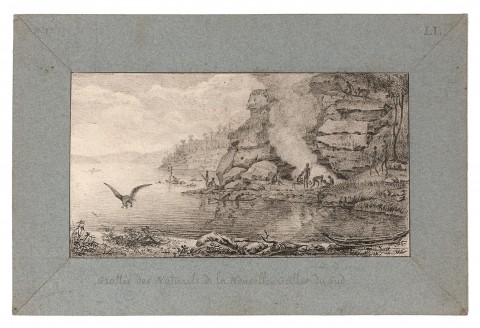GROTTES DES NATURELS DE LA NOUVELLE GALLES DU SUD, June – November 1802
CHARLES-ALEXANDRE LESUEUR
pen, ink and graphite on laid paper
a framing mount of blue-grey paper applied over the paper sheet
96 x 175 mm (image)
155 x 235 mm (sheet)
inscribed with title on mount lower centre: Grottes des Naturels de la Nouvelle Galles du Sud
inscribed upper left on mount: No. 1
inscribed upper right on mount: LI
This view was not included in the first edition atlas of 1807, but was added by Freycinet in the second edition of 1824 as the first illustration on plate 31 (and therefore as the companion view to lot 1 in the present list). The finished engraving was noted as C.A. Lesueur delint., J. Devilliers aqua forti, A. Delvaux sculpt.
possibly related to, at least in terms of locality, to Le Havre B:16043
A bucolic scene of life on the shores of Port Jackson with figures fishing and cooking. For the era this is a tremendously important scene, and further evidence that the French genuinely sought out the Sydney Aboriginal people in their traditional ways of life and did not, like many of their English compatriots almost 15 years after the First Fleet, content themselves with depictions of Aboriginal men and women in the township of Sydney proper. This offers a snapshot of a still vibrant culture that existed on the very edges of settlement.
This would not be published until the second edition of Baudin’s voyage, 1824, when it was the upper of two views on plate 31 (the lower was a companion scene of life on the Vasse River in Western Australia, lot 1 in this catalogue). When published, it was given a slightly fuller caption than here, which confirmed that it was Lesueur’s depiction of ways of life in Port Jackson (“Nouvelle-Hollande: Nouvelle-Galles du Sud. Grottes, chasse et pêche des sauvages du Port-Jackson”).
Although the relationship between this original sketch and the finished plate is very close, it is equally obvious that there are several important differences which make the finished version less lively, notably in the depiction of the human figures that populate the scene which have become in the engraving more lumpen (particularly in terms of the group at the fire and the family arriving at left). Lesueur’s depiction of the towering sandstone of the headland is particularly naturalistic, making it appear much more correctly weathered and less “blocky” than the finished engraving.
One quite remarkable aspect of the scene is the inclusion, at left, of the man lying down in the thick grass while an eagle hovers just above him. The clue as to what is being depicted is actually in a small pencil note in Le Havre which includes thumbnail sketches of various scenes of Aboriginal life (B:16009), the first of which is described as showing “un poisson dans la bouche, chasse aux aigles” (a fish in the mouth, hunting eagles). While this seems cryptic, it relates to something David Collins described in his 1798 book: “a native will stretch himself on a rock as if asleep in the sun, holding a piece of fish in his open hand; the bird, be it hawk or crow, seeing the prey, and not observing any motion in the native, pounces on the fish, and, in the instant of taking it, is caught by the native…” (An Account, p. 455).
For such a distinctive and well-known scene it is interesting to see that it bears little resemblance to any of the other sketches and studies recorded in Le Havre by Bonnemains.
There is however one very intriguing comparison to be made with the most fully elaborated scene of funerary rites done by Lesueur (B:16043) which has, in the middle ground, a towering shoreline not unlike that figured here.
Although unsigned, the attribution to Lesueur is confirmed by the subject matter and style; the fact that all of the other drawings in Le Havre are also by Lesueur; and that when it was finally published in 1824 the scene is noted as Lesueur “delint.”
